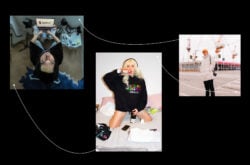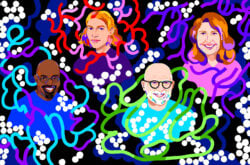I’ve heard it said that dancehall isn’t a style—it’s a place.
Well, originally it was a place, but it’s also a genre, and perhaps even more than that, a movement and a lifestyle. Dancehall has become a vehicle for the latest news, trends, slang, dance moves, and fashion coming out of Jamaica, as well as a snapshot of the lifestyles, feuds, and practices happening between dancehall artists and their camps and in Jamaica’s inner cities (though certainly not limited to those areas or their residents).
More than merely a beat or a rhythm, dancehall’s roots can be found in the early eras of Jamaican popular music. But, precursors to the wit, grittiness, and often bawdy nature can be found in Jamaican folk music—just as the integration of dance and fashion is foreshadowed by the trends we exported internationally via Jamaican immigrants seeking work and a better life for their children in North America, the UK, and Latin America.
Dancehall has influenced and been influenced, innovated and collaborated, and been a source of pride as well as contention and controversy. As it grows and morphs and reinvents itself, dancehall and several dancehall artists have been the “it” flavor in various communities at different times. It has been borrowed from and has borrowed. Some have even announced that dancehall is dead, or dying—yet it’s still here, contributing to local and international trends and brands.
Let us take a look beyond what you might already know or see, for a more vibrant picture of this mighty, morphing genre of Jamaican popular music. The journey will not be linear, as we’ll go back and forth in time, following the pathways to dancehall and attempting to track its influence, offshoots, and international progeny.
The history of dancehall
The Quadrille, a social dance of the French and English, was introduced to Jamaica in the early 19th century. There were two forms of the Quadrille: the Square (which became know as the Ballroom style and was mostly performed by elites such as those in the Planter class and the aristocracy) and the Long Way Set (which became known as Camp Style). The Quadrille is performed in four movements called figures, and a fifth was later added called the Mento.
As the added figure to the Quadrille, Mento became Jamaica’s first popular music form (now considered folk music), combining African and British elements. Mento really gained prominence in the 1940s and ’50s with some early recordings by Lord Flea, Lord Fly, and Sugar Belly.
Two important elements to note with the Quadrille and Mento are the aspect of social dance and the explicit tone and subject matter of many Mento songs. The social nature of the Quadrille as dance expression can be viewed as a direct line to the dance crews present in dancehall today.
Neila Ebanks, Director of Studies at The School of Dance, EMCVPA in Kingston observes, “Dancehall’s social nature has run the gamut from celebration of individual expression and style within the community to engendering group belonging (albeit strongly segregated according to gender).”
Dancehall was (and is) a place
As a place, the dancehall was where we would gather to dance ska, and before that, the Quadrille. The meaning of dancehall has since expanded from being the place where inner city communities would gather to have fun, celebrate, and express to being the vibrant, trendsetting movement we’re currently experiencing. Its distant folk roots are still evident and sometimes show up in the music, like that of Lloyd Lovindeer, Buju Banton, Chalice, and Gyptian, as well as in the dance and choreography of those like Bogle and Ding Dong.
Michael Holgate, Head of the Philip Sherlock Centre for the Creative Arts, UWI and Artistic Director for The Ashe Company says, “Dancehall is present-day folk dance. It is the dance of the folk. It is the dance of the people. The dancehalls of the past held the dances of the Quadrille and they continue through to this day now as remnants of history. The modern dancehalls are streets that live and breathe with the music, dance, and culture of dancehall as a social force.”
Deep connections with fashion
In the 1960s, the slang “rudeboy” gained prominence with ska and rocksteady to describe discontent youth in the Jamaican inner city. The slang and the rudeboy subculture would eventually find their way to England, among disenfranchised youth of Caribbean descent as well as poor British youth. This would eventually spawn the early skinhead culture.
Rudeboy (and rudegirl) fashion was influenced by the style of U.S. jazz and soul artists. Rudeboys often wore sharp suits and thin ties with trilby hats. Skinhead fashion would also include straight-leg jeans, steel-toe work boots, suspenders or braces, and slim-fit, button-down collar shirts.
Elements of these fashions are still evident in dancehall today, and varying philosophies of the rudeboy lifestyle can definitely be found in the lyrical content of dancehall. Dancer / choreographer Bogle’s fashion sense was most certainly influenced by skinhead and punk.
Though there was a brief departure in the ’80s, with dancehall fashion becoming colorful, larger-than-life, and at times outrageous (see ‘Dancehall Queen’ Carlene and dancehall designer Biggy), the rudeboy element never really left and now might be called “yardie,” “gangster,” or “badman,” and even more recently, “choppa.”
Dancehall is the sound of today and the movement is a trendy one. It has always had that spirit of fashion and it sets the trends for dance moves and the popular lexicon of the young and fashionable.
Contradictions
The dancehall space can be a conundrum. The subject matter can be uplifting as easily as it can be raunchy or offensive. Dancehall is cis male dominated. Many of the songs are about women, and many times in an explicitly sexual way. The dance crews are mostly men, and there are few mixed crews and crews of women.
The environment can feel androgynous at times, but for the most part that’s also one of the contradictions, as the space also tends to be a ‘macho’ one with all that comes with it.
Female dancehall artists almost always have to do more than their fair share of work and compromise to break in. “As a female in dancehall, we work twice as hard for half the pay and sometimes a quarter of the support,” dancehall artist Stacious shares. “We are held to higher standards but yet very little is expected from us. Very contrary. However, the love and passion for music allows us to cry, laugh, and fight at the same time, for the ability to produce music that inspires and entertains the masses. All while paying attention to the ‘age clock’ that society places on the heads of female acts. This… is a tiny summary of my love / hate relationship with [dancehall] music, or should I say the music industry.”
Mijanne, an accomplished violinist (who has toured with the likes of Jah Cure, Richie Spice, and KING DIANA), producer, and LGBTQ+ activist, shares her impression: “By my experience of it… it’s brash, aggressive, arrogant, and nuanced. [It’s] for the streets but exclusive, Christian but criminal… It’s [also] brilliant, intelligent and instinctive.”
KING DIANA (formerly known as DIANA KING) also shares their story: “I started pretty early in the business. I was between 13 and 15 years old… For me, it was mostly a toxic environment… where I was constantly managing my feelings in order to remain calm and just do the work. I didn’t know the correct wording for what I was experiencing at the time, but now I can say it was an extremely sexist and homophobic environment. I knew [given my identity] as a woman (now non-binary) and a closeted lesbian at the time… I would not flourish there, especially with my need to be authentically myself.”
System of a sound
In the 1950s and ’60s, sound systems provided the music in the dancehalls, and then they eventually found their way to the streets. These systems would have a turntable and large sets of speakers, and play records chosen by selectors. As the selectors would play early ska, rocksteady, and R&B, they would employ rudeboys and other musical hopefuls as “toasters,” who would fill the gap between records with lyrical rhyme and slang. The toasters would later become known as DJs, whose roles evolved to providing new lyrics over the instrumental versions of the records.
The sound of dancehall has evolved from the early sounds from toasters such as U-Roy and Sugar Minott to the DJs of the ’80s like Yellowman, Junior Reid, and Gregory Isaacs. In the ’90s, digital dancehall saw innovations in the sound and expansion of the genre. Producers like Bobby Digital, Dave Kelly, Donovan Germain, and Steely & Clevie pushed the boundaries of what came before with drum machines and synths.
Dancehall isn’t just one thing
In the ’90s, Cleveland ‘Clevie’ Browne took a basic rhythm (in 4/4: a dotted 8th note, 16th note, 8th note rest, 8th note, dotted 8th note, 16th note, 8th note rest, and 8th note) found in folk music across the Caribbean, Latin America, Africa, and Europe and distributed it to the kick and snare (the dotted 8th and 16th assigned to the kick drum, and the following 8th note assigned to the snare). This rhythm and its variations would become the basis for the identifiable sound of dancehall in that decade.
Variations on that rhythm (Dem Bow Riddim, Sister Nancy’s “Bam Bam,” “Murder She Wrote,” etc.) would go on to inspire other genres like reggaeton and dembow, and in turn, moombahton.
As mentioned, dancehall has been influenced and also influenced. In fact, those influenced by dancehall would in turn come back to influence and propel its sound. DJ and producer Diplo would collaborate with fellow DJs Walshy Fire and Ape Drums (also Switch and Jillionaire) under the name Major Lazer, infusing an EDM aesthetic with sounds of the Caribbean.
This collaboration introduced elements like the risers, falls, drops, and a plethora of synthetic sounds and samples to dancehall. The genre was already no stranger to experimentation and the use of sound effects, with electronic and vocal noises in its direct lineage via the dub studio experimentation of the likes of Lee Scratch Perry. The popularity of trap music has now also introduced those hi-hat patterns in trap dancehall, a polarizing new sub-genre.
Over the years, we’ve heard dancehall mixed with rock (Tessanne’s “Hide Away”), samba batucada (Busy Signal’s “Up in Her Belly”), classical (Chalice’s “Dance Hall Monic”), and more. The combinations and collaborations continue today with an almost cyclical influence between dancehall and Afrobeats.
Pinning down dancehall
With dancehall accepting influences and going on to birth or shape so many other styles and genres—from hip hop and garage to reggaeton and moombahton—how do you define it?
“Dancehall has some basic pillars [just] like hip hop: fashion, riddim, lyrics, artwork, and dancing,” DJ Walshy Fire says. “Dancehall is a drum pattern. It usually sits between 94 and 100 BPM. The bassline is the driving force to the sound. It even drives the lyrical direction, even though lyrically anything can be said over it. The bassline drives the energy. The energy is what makes dancehall so special—it’s put into a space uniquely its own.”
“Culture is a big part [of it],” producer and sample creator krs. adds. “The era or decade that the music is being made in kind of defines the sound. Growing up, I was hearing more melodic and produced beats that appealed to a more international crowd. I think that is less the trend currently. I would say the beat and the approach of the producer and artist come together to make something that showcases their local [Jamaican] environment—a slice of life. The story or subject matter would reflect their unique Jamaican story.”
From my own perspective as a musician, Jamaican, and consumer of dancehall, I would echo much of what has been said by krs. and Walshy Fire. I would also add that language is important, but not necessarily that it needs to be patois. The rhythm and cadence of the Jamaican language also drive the rhythm of the music and contribute to the energy and sense of culture that become palpable in the song. In addition to the inherent elements in the language and the musical and poetic adjustments made by DJs to establish unique musical identities within a vocal performance, there is also a veritable lexicon of slang, rhythmic phrasing, vocal texture, tone color, and attitudes inherited over the years which have become dancehall canon.
This vast palette of options for dancehall vocal performance allows someone singing in a completely different language to explore the lexicon and employ Jamaican cadences (specific to the genre), tonal inflections, and tried-and-true rhythmic patterns, thereby imbuing it with that dancehall energy.
With the many variations in beat and riddim, the stylistic fusions, and the international reach of dancehall, there needs to be at least one element of the production (many of which I mentioned here) that anchors the dancehall energy in the song.
You’re ultimately left with options. Will you research and study? Will you use hardware or software emulations for a vintage sound? Will you explore the cultures within Jamaica? Will you do a deep dive into the dancehall communities, fashion, and dance? Will you live and explore with a dance crew, as many now do? Will you experiment and attempt to push the music further? Will you be the one that inspires a new sub-genre? Discover the dancehall sounds below and start your journey.
Looking to explore dancehall in your own music? Check out exclusive sample packs from krs., Di Genius, Jaxx, and more:
August 26, 2022



